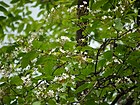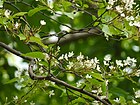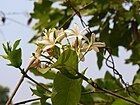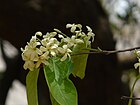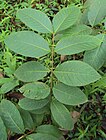Note: This is a project under development. The articles on this wiki are just being initiated and broadly incomplete. You can Help creating new pages.
Difference between revisions of "Holarrhena pubescens - Indrayavah, Kutajah"
| Line 31: | Line 31: | ||
Pitta, Kapha | Pitta, Kapha | ||
===Prabhava=== | ===Prabhava=== | ||
| + | |||
| + | ===Nutritional components=== | ||
| + | Holarrhena pubescens Contains the Following nutritional components like - Vitamin-C; Calcium, Iron, Magnesium, Manganese, Potassium, Phosphorus, Sodium, Zinc<ref name="Forest foods of Western Ghat"/> | ||
==Habit== | ==Habit== | ||
| Line 60: | Line 63: | ||
==How to plant/cultivate== | ==How to plant/cultivate== | ||
| − | Holarrhena pubescens can be propagated by seed, either by direct sowing or by raising seedlings in a nursery | + | Holarrhena pubescens can be propagated by seed, either by direct sowing or by raising seedlings in a nursery<ref name="How to plant/cultivate"/>. It is available through February to September<ref name="Forest foods of Western Ghat"/>. |
==Commonly seen growing in areas== | ==Commonly seen growing in areas== | ||
| Line 90: | Line 93: | ||
==References== | ==References== | ||
| − | |||
<references> | <references> | ||
<ref name="chemical composition">[http://bioinfo.bisr.res.in/project/domap/plant_details.php?plantid=0084&bname=Holarrhena%20antidysenterica Chemistry]</ref> | <ref name="chemical composition">[http://bioinfo.bisr.res.in/project/domap/plant_details.php?plantid=0084&bname=Holarrhena%20antidysenterica Chemistry]</ref> | ||
| − | |||
<ref name="Leaf">[http://www.flowersofindia.net/catalog/slides/Indrajao.html Plant description]</ref> | <ref name="Leaf">[http://www.flowersofindia.net/catalog/slides/Indrajao.html Plant description]</ref> | ||
<ref name="Ayurvedic preparations">[https://easyayurveda.com/2013/10/17/kutaja-benefits-usage-dose-side-effects-ayurveda-details/ Ayurvedic preparations]</ref> | <ref name="Ayurvedic preparations">[https://easyayurveda.com/2013/10/17/kutaja-benefits-usage-dose-side-effects-ayurveda-details/ Ayurvedic preparations]</ref> | ||
| − | |||
<ref name="How to plant/cultivate">[https://uses.plantnet-project.org/en/Holarrhena_pubescens_(PROTA) Cultivation Details]</ref> | <ref name="How to plant/cultivate">[https://uses.plantnet-project.org/en/Holarrhena_pubescens_(PROTA) Cultivation Details]</ref> | ||
| + | <ref name="Forest foods of Western Ghat">"Forest food for Northern region of Western Ghats" by Dr. Mandar N. Datar and Dr. Anuradha S. Upadhye, Page No.92, Published by Maharashtra Association for the Cultivation of Science (MACS) Agharkar Research Institute, Gopal Ganesh Agarkar Road, Pune</ref> | ||
</references> | </references> | ||
==External Links== | ==External Links== | ||
| − | |||
* [http://www.planetayurveda.com/library/kutaja-holarrhena-antidysenterica Holarrhena antidysenterica on planet ayurveda] | * [http://www.planetayurveda.com/library/kutaja-holarrhena-antidysenterica Holarrhena antidysenterica on planet ayurveda] | ||
* [http://www.homeremediess.com/holarrhena-antidysenterica-medicinal-benefits-and-images/ Holarrhena Antidysenterica Medicinal Benefits And Images] | * [http://www.homeremediess.com/holarrhena-antidysenterica-medicinal-benefits-and-images/ Holarrhena Antidysenterica Medicinal Benefits And Images] | ||
Revision as of 10:56, 10 November 2021
Holarrhena pubescens is a deciduous shrub or tree with fragrant white flowers and abundant white latex in all its parts. It grows up to 10 metres tall. An important medicinal plant in the tropics, it is gathered from the wild for its wide range of medicinal and other uses. The plant is sometimes cultivated for medicinal purposes, the root bark is sold in local markets.
Contents
- 1 Uses
- 2 Parts Used
- 3 Chemical Composition
- 4 Common names
- 5 Properties
- 6 Habit
- 7 Identification
- 8 List of Ayurvedic medicine in which the herb is used
- 9 Where to get the saplings
- 10 Mode of Propagation
- 11 How to plant/cultivate
- 12 Commonly seen growing in areas
- 13 Photo Gallery
- 14 References
- 15 External Links
Uses
Scabies, Ringworm, Itching, Arthritis, Osteoarthritis, Bleeding piles, Colic, Urinary tract infection, Vomiting.
Food
Indrayavah sabdariffa can be used in Food. Leaves are cooked as vegetable, fruits eaten raw.[1]
Parts Used
Chemical Composition
Conessidine, conessimine and isoconessimine, sonessine, conimine[2]
Common names
| Language | Common name |
|---|---|
| Kannada | Koodsaloo, Korchie |
| Hindi | Karva indrajau |
| Malayalam | Kutakappaala |
| Tamil | Kirimllikai |
| Telugu | Girimallika |
| Marathi | NA |
| Gujarathi | NA |
| Punjabi | NA |
| Kashmiri | NA |
| Sanskrit | Indrayava, Kutaja |
| English | Indrajao |
Properties
Reference: Dravya - Substance, Rasa - Taste, Guna - Qualities, Veerya - Potency, Vipaka - Post-digesion effect, Karma - Pharmacological activity, Prabhava - Therepeutics.
Dravya
Rasa
Tikta (Bitter), Kashaya (Astringent)
Guna
Laghu (Light), Ruksha (Dry)
Veerya
Sheeta (cold)
Vipaka
Katu (Pungent)
Karma
Pitta, Kapha
Prabhava
Nutritional components
Holarrhena pubescens Contains the Following nutritional components like - Vitamin-C; Calcium, Iron, Magnesium, Manganese, Potassium, Phosphorus, Sodium, Zinc[1]
Habit
Identification
Leaf
| Kind | Shape | Feature |
|---|---|---|
| Simple | Ovate | Oppositely arranges, ovate, obtusely acuminate leaves are 10-20 cm long |
Flower
| Type | Size | Color and composition | Stamen | More information |
|---|---|---|---|---|
| Unisexual | 5-15 cm | White | 5-20 | Flowers have five white petals 2-3 cm long which turn creamish yellow as they age |
Fruit
| Type | Size | Mass | Appearance | Seeds | More information |
|---|---|---|---|---|---|
| Simple | 7–10 mm | Clearly grooved lengthwise, Lowest hooked hairs aligned towards crown | Many | {{{6}}} |
Other features
List of Ayurvedic medicine in which the herb is used
- Kutajavaleha
- Brihat Gangadhara churna
- Maha Majishtadi kashayam
- Stanyashodhana kashayam
- Patoladi churna
Where to get the saplings
Mode of Propagation
How to plant/cultivate
Holarrhena pubescens can be propagated by seed, either by direct sowing or by raising seedlings in a nursery[5]. It is available through February to September[1].
Commonly seen growing in areas
Wild in mountains, Meadows, Borders of forests and fields.
Photo Gallery
References
- ↑ 1.0 1.1 1.2 "Forest food for Northern region of Western Ghats" by Dr. Mandar N. Datar and Dr. Anuradha S. Upadhye, Page No.92, Published by Maharashtra Association for the Cultivation of Science (MACS) Agharkar Research Institute, Gopal Ganesh Agarkar Road, Pune
- ↑ Chemistry
- ↑ Plant description
- ↑ Ayurvedic preparations
- ↑ Cultivation Details
External Links
- Ayurvedic Herbs known to be helpful to treat Scabies
- Ayurvedic Herbs known to be helpful to treat Ringworm
- Ayurvedic Herbs known to be helpful to treat Itching
- Ayurvedic Herbs known to be helpful to treat Arthritis
- Ayurvedic Herbs known to be helpful to treat Osteoarthritis
- Ayurvedic Herbs known to be helpful to treat Bleeding piles
- Ayurvedic Herbs known to be helpful to treat Colic
- Ayurvedic Herbs known to be helpful to treat Urinary tract infection
- Ayurvedic Herbs known to be helpful to treat Vomiting
- Herbs with Bark used in medicine
- Herbs with Seeds used in medicine
- Herbs with common name in Kannada
- Herbs with common name in Hindi
- Herbs with common name in Malayalam
- Herbs with common name in Tamil
- Herbs with common name in Telugu
- Herbs with common name in Sanskrit
- Herbs with common name in English
- Habit - Deciduous shrub
- Index of Plants which can be propagated by Seeds
- Index of Plants which can be propagated by Cuttings
- Herbs that are commonly seen in the region of Wild in mountains
- Herbs that are commonly seen in the region of Meadows
- Herbs that are commonly seen in the region of Borders of forests and fields
- Herbs
- Ayurvedic herbs that don't have seed photos
- Apocynaceae

